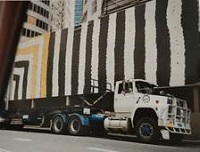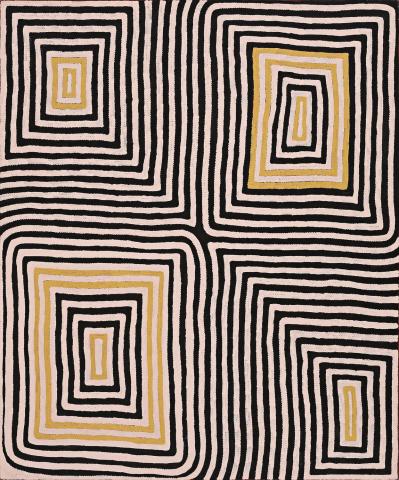WILKINKARRA (LAKE MACKAY), 1993
RONNIE TJAMPITJINPA
synthetic polymer paint on linen
182.0 x 153.0 cm
bears inscription verso: artist's name, size and Papunya Tula Artists cat. RT930734
Papunya Tula Artists, Alice Springs
Utopia Art Sydney, Sydney
Peter and Des Hunter, Sydney
Sotheby’s, Melbourne, 26 June 2000, lot 119
Private collection, Melbourne
Australian Perspecta 1993, Art Gallery of New South Wales, Sydney, 6 October – 28 November 1993
Ronnie Tjampitjinpa: A Solo Exhibition, Utopia Art Sydney, Sydney, April 1994 (illus. on invitation)
Australian Perspecta 1993, Art Gallery of New South Wales, Sydney, 1993, pp. 82 – 83 (illus.)
Ronnie.jpg

painting were displayed on
hoardings during construction at
Aurora Place, Sydney completed
in 2000
This painting is accompanied by a certificate from Papunya Tula Artists.
It was in the 1980s that Ronnie Tjampitjinpa emerged as one of the major painters of the Papunya Tula movement, described by Vivien Johnson as ‘pioneering the bold, scaled-up, linear style that came to dominate many of the Walungurru painters’ work during the 1990s’.1Tjampitjinpa was one of the youngest men to begin painting at Papunya in 1971 and one of the founders of the hugely influential Papunya Tula Artists group. Under the tutelage of Uta Uta Tjangala, and encouraged by school teacher Geoffrey Bardon, Tjampitjinpa shared stories of his distant homelands through his artworks. His early paintings and, indeed, all his works, are characterised by classic episodes from the travels of the Tingari – a mythical group who moved across vast stretches of the Western Desert sharing law and creating and naming places.
Tjampitjinpa’s later paintings are reductive and vivid, optical works that pulsate with energy and this distinctive aesthetic is exemplified by Wilkinkarra (Lake MacKay), 1993. In this painting, Tjampitjinpa has taken a square, one element of his visual lexicon, and enlarged and repeated it over and over in alternate colours, creating four monumental forms. These squares don’t sit together in balance; rather, they push and twist against one another creating tension and energy. Each upscaled geometric element, representing one part of the Tingari story, is the product of two decades of refinement by the artist in charting the vast terrain of the Western Desert in his own deft visual language. The related story is part of the Tingari cycle and tells that in mythological times a large snake travelled to the area and created Wilkinkarra (Lake Mackay), which became its home. In an area on the east side of the lake, two men set a fire which burned out the lake, and when the snake found himself with a bushfire sweeping upon him and was severely burned he fled, eventually settling at his final resting place near Jupiter well further west.2
Ronnie Tjampitjinpa has been the recipient of a number of awards, including the 1988 Alice Prize. His first solo exhibition was held at Gallery Gabrielle Pizzi, Melbourne, in 1989, and his work was included in Dreaming at the Asia Society Gallery, New York in 1988 and Australian Perspecta in 1993. More recently an exhibition celebrating 40 years of the artist’s work was held at the Art Gallery of New South Wales in 2015.
1. Johnson, V., ‘Ronnie Tjampitjinpa’, in Perkins, H., Tradition Today, Indigenous Art in Australia, Art Gallery of New South Wales, Sydney, 2006, p. 140
2. Taken from the accompanying certificate
CRISPIN GUTTERIDGE
